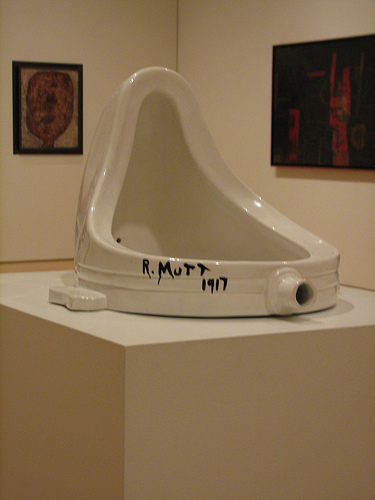Celebrating 100
Years of Being Gaslighted by Modern Art.

A urinal which Marcel Duchamp titled Fountain and signed "R. Mutt". It is regarded by the art establishment as a major landmark in modern art. Replicas commissioned by Duchamp in the 1960s are now on display in a number of different museums around the world.
Karla Blacks suspended paper and plastic sheeting,
called Pleaser. Black was shortlisted for the prestigeous Turner Prize in 2011.
The niece of a friend of mine was a brilliant and
gifted young artist. She won a scholarship to one of the world's most
prestigious art schools - where she presented a portfolio of her stunning
drawings and watercolours. By the time she graduated, she had not picked up a
brush or pencil in over a year and was stapling bird feathers to an old
shipping pallet as her graduation work. She now works as a receptionist at a
dental clinic.
The term "Gaslighting" is used to describe
how a psychopath in a personal relationship with another person will slowly
over time change the reality and perceptions of the individual they are
targeting. A proficient psychopath will, in time, have a once perfectly stable
and emotionally healthy person literally believing that black is white and up
is down. Essentially, the psychology of the target has been altered in a way to
accept what they see before their own eyes - is not what they once
believed it to be.
One of the most effective forms of public
gaslighting has been modern art. As a rule, I do not like to put down
other artists work. But there seems to be almost a secret cabal between public
bodies, art colleges, some artists and exhibition spaces/managers to fill these
spaces with shock art or art which is as uninspiring as possible. The vast
majority of public and corporate funding goes into promoting these forms
of art - while gifted talented traditional artists have to beg private
galleries to stock their work with commissions up to 50% on the sale price not
uncommon.
I came upon one installation
recently which was an old telephone on a table with a present day
directory beside it. From the telephone there was a wire extending up to a
glass box on the wall - which contained a life sized sculpture of the
human ear made of the artist's own ear wax. I see this kind of thing is
everywhere in public art spaces now - in fact, I can hardly recall a time when
this sort of art did not fill public art spaces. Such
"modern" art - from around the time of DaDa movement on
- still continues to win all the art awards and the artists proclaimed as
geniuses right to the present day. No other art movement in history has
survived for so long.
The rationale used to defend this degradation of
art is; that all expression should be free and unlimited. That the
"concept" behind the work is more important than the artwork itself.
Highly paid members of art councils, college professors and media will
invoke "freedom of expression" and pontificate about the Nazis and
the concepts of degenerate arts and "what it led too..." The irony
being, that the greatest censorship in the art world today is by these same
individuals against more traditional artistic expressions in terms of painting,
drawing and sculpture.
As with everything on this face of this planet
which makes no sense to most humans, there is always a underlying psychopathic
rationale/drive for how this situation has come about. In this case, the
degradation of the aesthetic, along with our notions of emotional
resonance when viewing artwork - is being used to make
corporate advertising more appealing.
The powers that be are gaslighting the rest of us by changing our
perceptions - so corporate advertising looks more beautiful and
uplifting than the art inside the galleries. When people visit spaces such
as the Tate Modern in London to have their consciousness
perverted, twisted and distorted into a mundane cul-de-sac of spiritually
and emotionally vapid installations - they will come outside and see colourful
advertisements. The psychological impact of the advertisement is then far more
powerful on the viewer. Charles Saatchi of the global advertising agency
Saatchi & Saatchi, is also known worldwide as an art collector and
owner of the Saatchi Gallery, and in particular for his sponsorship of the
Young British Artists (YBAs), including Damien Hirst and Tracey Emin.
Thomas Sheridan is an independent alternative
artist, author, satirist, musician, public speaker, broadcaster and researcher
currently based in the West of Ireland. His illustrations have appeared on the
covers of newsstand magazines, books and websites worldwide.
The Anvil of the Psyche is considered a
vital manual for personal and social survival in a world controlled by greed
and false hopes. Thomas' writings and interviews have evolutionised people to
build a firewall around their own psyche and not to be lured into handing over
personal independence to an exterior collective or guru. As a result, his NO CONTACT EVER AGAIN philosophy
applied to controlling individuals and groups has made Thomas an enemy of mind-controlled death cults and
neo-Nazi fringe groups. Thomas has also been featured in several films
and documentaries.
Posted by
Thomas Sheridan
